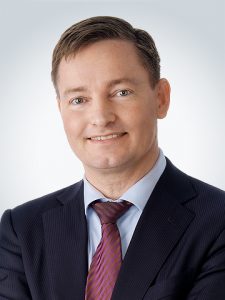The legal advisory market is undergoing fundamental changes: in light of legal tech, cost pressure, increasing professional specialization and transparency, corporate law firms need to work on their value proposition. In the first part of our interview series, Jacob Christensen shows how price and quality impact the value proposition.
Mr Christensen, what are the main components contributing to a law firm’s value proposition to customers?
 Christensen: I would like to highlight three main areas where we as lawyers can strive to differentiate ourselves and make a positive impact. Obviously, the price of a given legal service will most frequently be of significant importance to the customer paying for it. The same goes for the quality of the advice given. The last category could go under the joint caption Serviceability which covers a wide range of issues and parameters of importance to a customer relationship including availability, likeability, pro-activeness, 360 degree risk and opportunity focus, customer focus and trust.
Christensen: I would like to highlight three main areas where we as lawyers can strive to differentiate ourselves and make a positive impact. Obviously, the price of a given legal service will most frequently be of significant importance to the customer paying for it. The same goes for the quality of the advice given. The last category could go under the joint caption Serviceability which covers a wide range of issues and parameters of importance to a customer relationship including availability, likeability, pro-activeness, 360 degree risk and opportunity focus, customer focus and trust.
What are the challenges and options when it comes to price?
Christensen: The first challenge is to understand the customer’s expectations at the outset of a given task. Is this a bet the company issue, a technical/commodity issue or something in between? As part of this match of expectations, it may be relevant to challenge the customer’s initial assumptions. Perhaps there is an easy fix to something the customer had perceived as a complex issue. On the other hand, something the customer may perceive as a trivial technical issue, may actually carry a much higher value potential – either positively as a potential unrealized opportunity or more detrimentally as an issue representing a significant risk of reputational and/or financial damage such as huge fines or compensation claims in the event the issue is not adequately addressed.
But often enough it depends on the perspective, whether or not a price is acceptable…
Christensen: Yes – therefore, another challenge is to make respective fee and billing expectation ends meet. While traditional billing and discount models may provide somewhat limited room for maneuvering, a number of alternative fee arrangements could be introduced. The more trust- and transparency-based the relation is, the easier it becomes to identify what solution is best suited to fit the customer’s true needs.
Can you give an example to make it more tangible?
Christensen: Sometimes the answer can be as simple as a fixed price arrangement, on other occasions a more complex fee model can be the key. One item we try to include in more long-term engagements is a “satisfaction guarantee” clause whereby the customer should never pay more for a service than what the customer believes it has been worth. While this may seem like a slightly scary standard to commit to at first, it actually shouldn’t be a problem in a trust-based relation, and in my nearly 28 years of practice I have only had one experience where I felt that a customer took undue advantage of such commitment.
Sounds reasonable. However, most of the corporate law firms still practice the hourly billing model. Hence, a satisfaction guarantee is likely to collide with this system.
Christensen: Indeed, the ability to balance customer tailored fee arrangements with the law firm’s internal more standardized budgetary requirements and expectations is often a challenge. This also ties in with the frequent “more for less” customer expectation. Obviously it is not an option to allow the quality of your advice or service to suffer. Here I think that developments in LegalTech will become an important contributing factor along with your ability to streamline replicable work processes and your ability to attract and retain a highly qualified and motivated service focused team.
When it comes to quality, customers are likely to have very high expectations. Is it possible to offer added value there?
Christensen: This is certainly true and you might say that providing services of the highest quality is a fundamental license to play requirement to act as legal advisor. I still think it is possible to challenge yourself to strive for excellence and to have your team differentiate itself positively also in this respect.
To what extent?
Christensen: For instance, your response to a legal question may be technically correct but still not represents excellence for a number of reasons. Perhaps the question was not sufficiently comprehensive in context of the customer’s situation, or your answer does not represent a satisfactory commercial solution to the issues at hand, or maybe it doesn’t address all relevant risks and opportunities or take relevant alternative future outcomes into account. These are among the specific areas we focus on refining in our team.
How exactly do you refine?
Christensen: Our team thrives on sports metaphors and in this respect as a general approach, we tried to look at ourselves as a Formula one team. You need the legal equivalent of a Formula One car (your team) to enter the season, but then you need to tweak and fine tune that car to win the first Grand Prix and then for each subsequent race to adapt it to the differing track- and climate conditions and avoid mistakes so you end up leading and winning the championship. If this standard of excellence and alignment is the ambition and motivation driving each member of your team – and if your team truly believes in the power of working together as such, it is certainly possible to develop a differentiating magic touch also as far as quality is concerned. With this mindset firmly in place, a lot is gained simply by asking the customer the right questions (including the difficult ones) and thereby tuning your effort to understand and match the customer’s need. The more information you have about the 360-degree environment surrounding the customer’s issue, the more likely you are to come up with a solution that best accommodates not only legal risks and opportunities but also the commercial value drivers and issues at stake as well as all other relevant angles and actual and potential future developments.



